
Kumbakonam, or Kudanthai, is a city municipal corporation in the Thanjavur district in the Indian state of Tamil Nadu. It is located 40 km (25 mi) from Thanjavur and 282 km (175 mi) from Chennai and is the headquarters of the Kumbakonam taluk of Thanjavur district. It is the second largest city in the district after Thanjavur. The city is bounded by two rivers, the Kaveri River to the north and Arasalar River to the south. Kumbakonam is known as a "Temple town" due to the prevalence of a number of temples here and is noted for its Mahamaham festival, which happens once in 12 years, attracting people from all over the country.

Mahamaham, also known as Mahamagham or Mamangam, is a Hindu festival celebrated every 12 years in the Mahamaham tank located in the city of Kumbakonam in Tamil Nadu in the south of India. This 20-acre square tank surrounded by Shiva mandapams is believed by Tamil Hindus to be ancient, and the holy confluence of nine Indian river goddesses: Ganga, Yamuna, Sarasvati, Narmada, Godavari, Krishna, Tungabhadra, Kaveri, and Sarayu, states Diana Eck – a professor of Comparative Religion and Indian Studies. On the day of the Mahamaham festival, the river goddesses and Shiva gather here to rejuvenate their waters, according to a legend in the Periya Purana. The Hindus consider taking a pilgrimage and holy dip at the Mahamaham tirtha on the day of Mahamaham festival as sacred. The event attracts chariot processions, street fairs and classical dance performances in temple mandapas. The 12-year cycle Mahamaham festival in Tamil Nadu is observed in the Hindu calendar month of Magha, and is a symbolic equivalent of the Kumbh Mela.
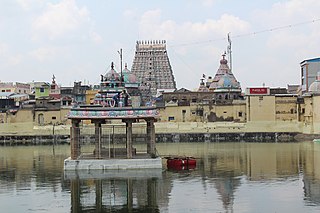
Adi Kumbeswarar Temple, Kumbakonam is a Hindu temple dedicated to Shiva, located in the town of Kumbakonam in Thanjavur District Tamil Nadu, India. Shiva is worshiped as Adi Kumbeswarar, and is represented by the lingam. His consort Parvati is depicted as Mangalambigai Amman. The presiding deity is revered in the 7th century Tamil Saiva canonical, greatest work, the Tevaram, written by Tamil saint poets known as the Nayanmars and classified as Paadal Petra Sthalam.

Oppiliappan Temple, is a Hindu temple dedicated to Vishnu, located near Thirunageswaram and also known by its old toponym Thiruvinnagar, a village in the outskirts of the Kumbakonam in the South Indian state of Tamil Nadu. Constructed in the Dravidian style of architecture, the temple is glorified in the Naalayira Divya Prabandham, the early medieval Tamil canon of the Alvar saints from the 6th–9th centuries CE. It is counted as the 60th of the 108 Divya Desams dedicated to Vishnu. Vishnu is worshiped as Oppiliappan and his consort Lakshmi as Bhudevi.
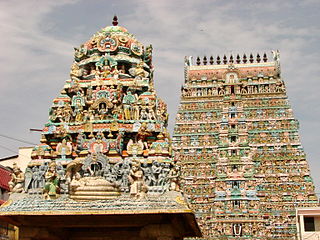
The Sarangapani Temple, Thirukudanthai, or Kumbakonam koyil is a Hindu temple dedicated to Vishnu, located in Kumbakonam, Tamil Nadu, India. It is one of the Divya Desams, the 108 temples of Vishnu revered in Nalayira Divya Prabandham by the 12 poet saints, or Alvars. This temple is along Kaveri and is one of the Pancharanga Kshetrams.

The Adi Jagannatha Temple is a South Indian Hindu temple in Thiruppullani, a village in the outskirts of Ramanathapuram in the South Indian state of Tamil Nadu, is dedicated to the Hindu god Vishnu. It is believed that Rama used grass ('pul' in Tamil as a pillow to sleep and hence the village attained the name Thiruppullani. Constructed in the Cholan style of architecture, the temple is glorified in the Naalayira Divya Prabandham, the early medieval Tamil canon of the Alvar saints from the 6th–9th centuries CE. It is one of the 108 Divya Desam dedicated to Vishnu, who is worshipped as Adi Jagannatha and his consort Lakshmi as Padmasini.
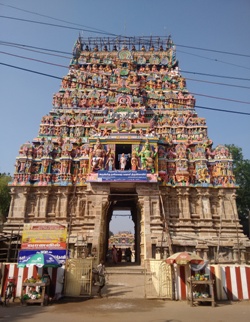
Nageswaraswamy Temple is a Hindu temple dedicated to Shiva located in Kumbakonam in Thanjavur district, Tamil Nadu, India. The presiding deity is revered in the 7th-century Tamil Saiva canonical work, the Tevaram, written by Tamil poet saints known as the nayanars and classified as Paadal Petra Sthalam. The temple is counted as the earliest of all Chola temples. Shiva in the guise of Nagaraja, the serpent king..
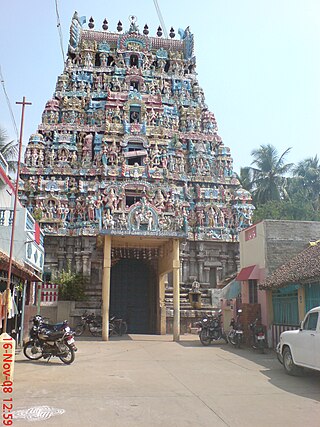
Kasi Viswanathar Temple, Kumbakonam is a Hindu temple dedicated to Lord Shiva, located in Kumbakonam, Tamil Nadu, India. Here, Lord Shiva is worshipped as Kasi Viswanathar, and His consort Parvati is depicted as Visalakshi. The presiding deity is revered in the 7th-century Tamil Saiva canonical work, the Tevaram, written by Tamil saint poets known as the nayanars and classified as Paadal Petra Sthalam.

Mahamaham tank is a huge temple tank located in Kumbakonam, Tamil Nadu, India. It is considered to be the foremost and one of the largest temple tanks in Tamil Nadu. The Masimaham festival held in the tank has 100,000 visitors and the once-in-12-year Mahamaham festival has close to 2 million visitors.

Parimala Ranganathar Perumal Temples or Tiruindaloor is a Hindu temple dedicated to Vishnu, located in Thiruvilandur of Mayiladuthurai, a town in the South Indian state of Tamil Nadu. It is one of the Divya Desams, the 108 temples of Vishnu revered in Nalayira Divya Prabandham by the 12 poet saints, or the Alvars. This temple is along Kaveri and is one of the Pancharanga Kshetrams.

The Gajendra Varadha Perumal Temple in Thirukkavithalam, a village in the outskirts of Papanasam in the South Indian state of Tamil Nadu, is dedicated to the Hindu god Vishnu. Constructed in the Dravidian style of architecture, the temple is glorified in the Nalayira Divya Prabandham, the early medieval Tamil canon of the Alvar saints from the 6th–9th centuries CE. It is one of the 108 Divya Desams dedicated to Vishnu, who is worshipped as Gajendra Varadha Perumal and his consort Lakshmi as Ramamanivalli. The temple is one of the five Pancha-Kannan temples, where Krishna, an avatar of Vishnu is given prominence over the presiding deity.

Thanjai Mamani Koil, Thirutanjai, or Thanjavur Perumal Temple is a set of three adjacent Hindu temples dedicated to Vishnu located in Thanjavur, Tamil Nadu, India. It is one of the Divya Desams, the 108 temples of Vishnu revered by the 12 poet saints called the Alvars. Unlike other Divya Desams where a single shrine is referenced, this set of temples is referred together in all the pasurams.

Chakrapani Temple is a Hindu temple dedicated to God Vishnu located in Kumbakonam, Tamil Nadu, India. This temple is located 2 km, away towards North West from the Kumbakonam Railway Station. Vishnu appears in the form of a discus or Chakra to put down the pride of Surya, who subsequently became his devotee. Like Shiva, Lord Chakrapani has a third eye on His forehead. The temple is one of the prominent Vishnu temples in Kumbakonam.

Apathsahayar Temple, Thirupazhanam is a Hindu temple dedicated to Shiva located in Thirupazhanam near Tiruvaiyaru, Tamil Nadu, India. The presiding deity is revered in the 7th century Tamil Saiva canonical work, the Tevaram, written by Tamil poet-saints known as the nayanars and classified as Paadal Petra Sthalam. The temple is counted as the earliest of all Chola temples.

Amirthakadeswarar Temple is a Hindu temple dedicated to the deity Shiva, located at Sakkottai in Tamil Nadu, India. The temple is dedicated to Shiva. Shiva is worshiped as Amirthakadeswarar, and is represented by the lingam. His consort Parvati is depicted as Amirthavalli Amman. The presiding deity is revered in the 7th century Tamil Saiva canonical work, the Tevaram, written by Tamil saint poets known as the Nayanmars and classified as Paadal Petra Sthalam.

The Bhu Varaha Swamy temple is a Hindu temple, located at Srimushnam, in the South Indian state of Tamil Nadu. Constructed in the South Indian style of architecture, the temple is dedicated to Varaha, the boar-avatar of the god Vishnu and his consort Lakshmi as Ambujavalli Thayar. It is Classified one among the 108 Abhimana Kshethram of Vaishnavate tradition. One of the greatest Hindu scholars of Vaishnava Tattvavada (Dvaita) philosophy, Madhvacharya, have come and resided in this temple many times.
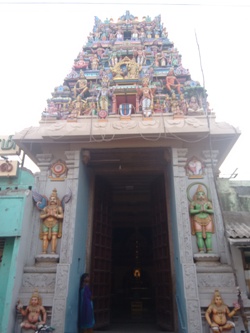
Rajagopalaswamy Temple is a Hindu temple dedicated to Vishnu located at Kumbakonam in Thanjavur district, Tamil Nadu, India.
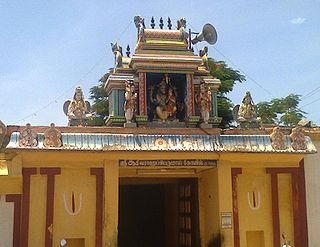
Varahaperumal Temple is a Hindu temple dedicated to Varaha at Kumbakonam in Thanjavur district, Tamil Nadu, India.

2016 Mahamaham is a recurring festival most recently celebrated at Kumbakonam in Thanjavur district of Tamil Nadu, India from 13 February 2016 to 22 February 2016. Mahamaham, also known as Mahamagham or Mamangam, is a Hindu festival celebrated every 12 years in the Mahamaham tank in Kumbakonam.






















